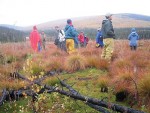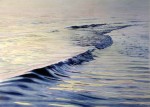Golden foliage greeted a dozen writers and a handful of scientists at the Bonanza Creek (BNZ) LTER site outside of Fairbanks on a recent Sunday in September. The focus of their interest was the 2004 Boundary Fire, one of the largest fires of that record fire season, which scorched 6.7 million acres. Together we looked at the ecological consequences and remembered the year that it occurred. Was the ecosystem devastated or was this part of natural rhythms of boreal forests? How did that summer's smoke color the perceptions of Fairbanks residents about boreal wildfires, which had robbed them of that scarce resource called summer?
An evening of discussion and readings of fresh writings at BNZ LTER PI Terry Chapin's house carried the conversation further and led to plans for further collaboration between writers and scientists, as well as presentations to broader public audiences.
This project began as an outgrowth of the Long-Term Ecological Reflections program that regularly brings writers to the Andrews Forest LTER site (see LTER Network News Spring 2005 and online at http://www.fsl.orst.edu/lter/research/related/writers.cfm?topnav=167. Realizing that Bonanza Creek LTER has many science themes in common with the Andrews Forest LTER, such as disturbance and recovery, these two LTER sites are collaborating to initiate similar gatherings of writers, artists, and scientists in Alaska. Future gatherings will hopefully include humanists and scientists from multiple LTER sites.
Budding collaborations between the arts, humanities, and science are developing elsewhere within the LTER network. The North Temperate Lakes (NTL) LTER is in the second year of a project in which artists and scientists share their concerns about the effects of climate change in the Lake States (Wisconsin, Minnesota, and Michigan). In May 2006, 20 artists, seven scientists, and six educators met to discuss climate change and the potential role of art in increasing public awareness about science. The group visited selected field sites and learned about the scientific understanding of climate change and its effects on ecosystems in the NTL-LTER region. The artists then created paintings, sculpture, poetry, and music reflecting their perceptions of the science of climate change, its impacts on northern ecosystems, and the actions that can be taken now to lessen those impacts. These pieces were then assembled into an exhibit along with related scientific information and visuals.
The exhibit is now on display in a series of showings in Wisconsin and Michigan galleries and campuses. During the tour, educators visit middle and high schools in each community prior to the exhibit's arrival and engage students in science and art activities focusing on climate change. The students are encouraged to create artwork that is included in the exhibit in their community. A reception and panel discussion are held in each community at the opening of the exhibit. More information, including the art works, can be found at www.wisc.edu/cbe/K12/paradiselost.html

 Enlarge this image
Enlarge this image
